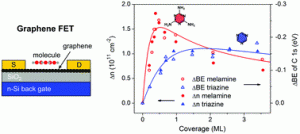Graphene has been the focus of intense research over the past couple of decades. Its unique optical, electrical, thermal and mechanical properties mean that graphene is the ideal 2D material for probing interfacial interactions. The ability to tune the electronic properties of graphene has enabled the highly sensitive detection of various gases, biomolecules and organic molecules. However, the ability to perform selective measurements using such substrates remains a significant barrier needing to be overcome.
Cervenka and co-workers have devised graphene field electric transistors (FETs) to study the interfacial interactions of two nitrogen hetrocycles, using the knowledge that the electronic structure of graphene can be tuned between n and p-type doping due to the adsorption of electron donating/accepting molecules. Using a combination of electronic transport and XPS measurements this study has shown that molecular recognition can be achieved through the use of FETs due to the presence of non-polar and polar moieties within the analyte molecules.
Significantly, the simplicity of this study opens up the possibility of studying a variety of chemical species selectivity on graphene based sensor devices.
Graphene field effect transistor as a probe of electronic structure and charge transfer at organic molecule–graphene interfaces
Jiri Cervenka, Akin Budi, Nikolai Dontschuk, Alastair Stacey, Anton Tadich, Kevin J. Rietwyk, Alex Schenk, Mark T. Edmonds, Yuefeng Yin, Nikhil Medhekar, Martin Kalbac and Chris I. Pakes
Nanoscale, 2015, 7, 1471-1478. DOI: 10.1039/C4NR05390G
Dr Derek Craig is a guest web writer for the Nanoscale blog. He is a Post Doctoral Research Fellow at the University of St. Andrews based in the fields of Biophotonics and Materials Science. With a background in chemistry, his work mainly focuses on the synthesis of nano to meso materials and the use of imaging techniques to study biological samples.











